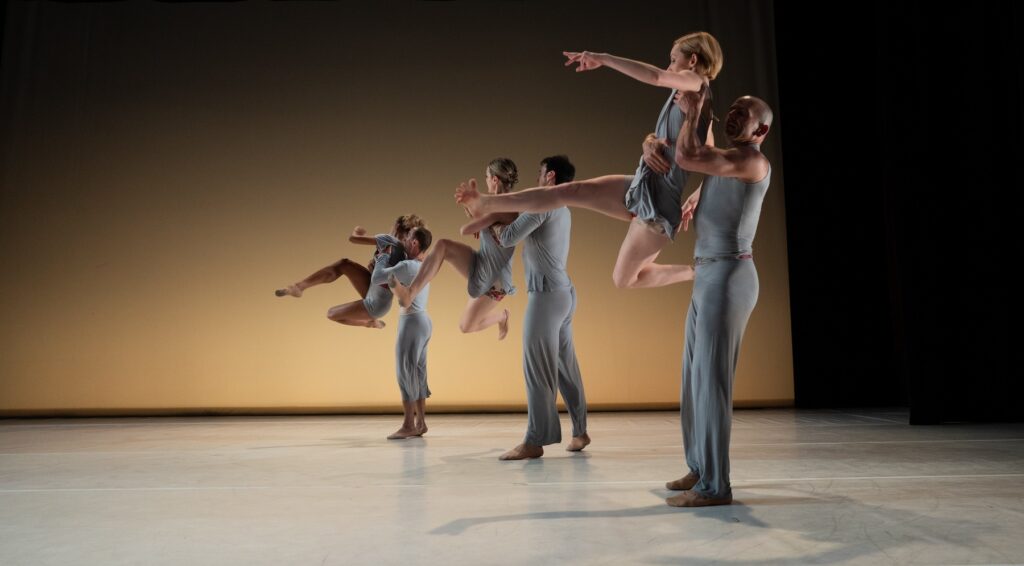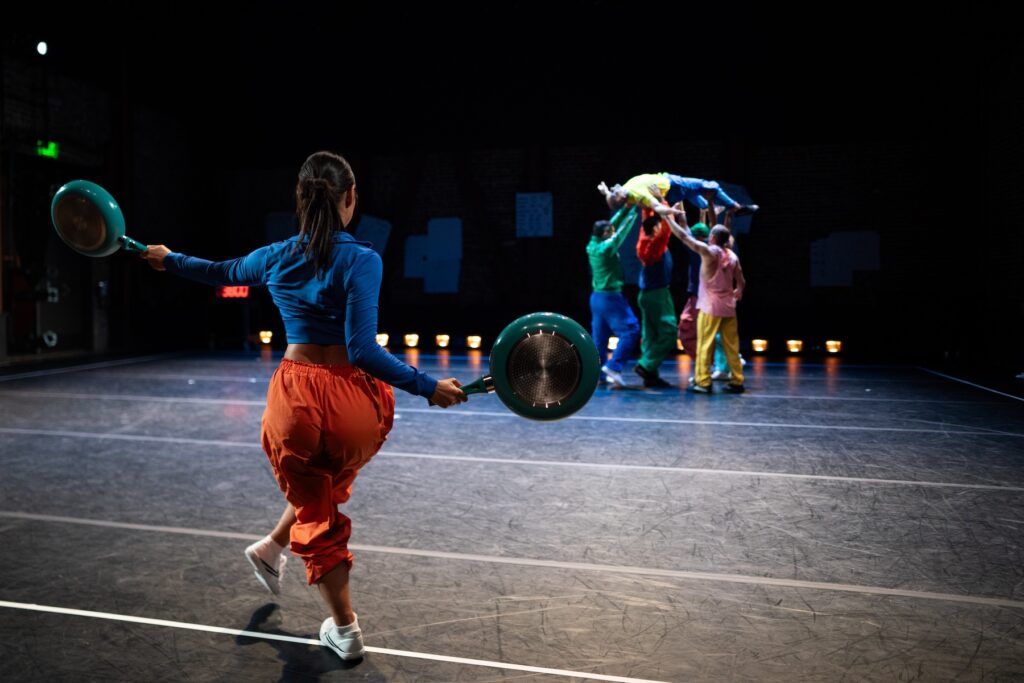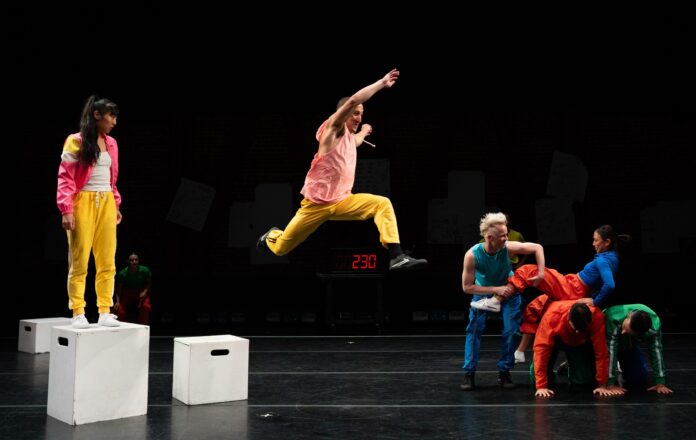Before the show began, ODC artistic director and founder Brenda Way dedicated the night to her friend “Ellie” who had recently passed. Way thanked Ellie for her inspiration and her many contributions to the work of the company. It wasn’t until I saw the show’s proper digital program that I learned “Ellie” was the late Eleanor Coppola, matriarch of the legendary film dynasty and occasional costumer for ODC. It was a poignant reminder that life goes on, and art leaves an indelible legacy.
Yet mourning was far from the theme of the evening. Indeed, ODC’s season-ending Summer Sampler, which took place last weekend, seemed to be focused on life, both its beginnings and proliferations. Perhaps the question of the evening was “What makes humans unique?” That the question was asked in the city of ChatGPT and robotaxis only adds to its provocative inquiry.
The program started with Way’s own A Brief History of Up and Down. As the full company of 11 dancers appeared on blue light-bathed stage, Alexander V. Nichols’ projections unfurled in Courier type on the upstage wall, with accompanying typing sound: “Can any action be dance?” Soon, members of the company began engaging in that most rudimentary of human actions: walking. “When does walking become dancing?” the projection then asked. The white-clad troupe’s movements became more and more complex with each passing query—all done without music, in an almost John Cage-like method of keeping everyone’s ears alert. (A few giggles were heard at a certain point).

The questions were intriguing and the movements well-crafted (particularly the way four dancers stood shoulder to shoulder and seemed to “pass” the energy of movement to one another), but this early half of Way’s piece felt more like an exercise than an expression. It wasn’t until we receive a question about gravity—accompanied by dancers lifting one another—that the piece began to evolve from a drill to a means of living in the moment. A chamber tune began, dancers left and returned dressed in gray, a harmony was found amongst the troupe. They’ve evolved from basic practitioners into sentient, passionate beings.
Indeed, one of the more striking tableaus found two dancers centerstage in a top-down spotlight as they embraced romantically, the rest of the company not quite disappearing into the shadows upstage. The piece ended with the dancers engaged in what could only be described as a modern dance version of playing tag. Because what’s the point of being a sentient being if not to have fun?
Way’s official statement describes the piece as reflective of “the aesthetic evolution that has taken place in dance over the 53-year lifespan of ODC/Dance, from simple movement to virtuosity. From the perspective of this show, it’s been quite a journey.
We returned from intermission to find the once-white stage stripped of its covers and now jet-black, save for white tape that made a square about a foot away from its border. The first of many white stage cubes sat upstage-right. A small digital display showed five zeroes. This would be our counter for the world premiere of Catherine Galasso’s 10,000 Steps.
Since first being proposed as a Japanese fitness goal in 1965, the 10,000-step benchmark has—like all fitness trends—been a deterrent to the non-athlete as much as an achievement. 10,000 steps may not be much for some able-bodied movers, but the large-sounding number can intimidate others. For the full troupe of ODC—decked out in blinding neon by Galasso and Kyo Yohena—it barely scratched the surface.

The overall tone is one of play, with one member holding a manual clicker that increased the counter’s number. Dancers stepped in-and-out of the white border, with everything inside being counted, unless you’re standing on a white cube. Does writhing around on the belly count? Floating across on a roller skate? The counter kept rising, all the same.
Yet, at one point, the clicker was discarded, but the counter continued, as if the floor were pressure-sensitive. (Which I consider unlikely, given the budget of indie theatre.) Certain goals—500 steps, 7,717 steps—called out by a Siri-like voice pushed the troupe toward the 10,000. However, there was a sense that this “encouraging” AI may not have their best interests at heart. We were given a monologue by dancer Jenna Marie about Ascidiacea (“sea squirts”) that move a certain distance before eating their own brains, as they no longer need them.
So, what was to happen to our troupe when they’ve reached their titular goal? Was there nothing more than reaching the number?
Combined, both pieces carried the theme that we humans should think of ourselves as more than goals to be achieved or landmarks to be reached. The point was that we can (or can’t) do those things, but what we do along the way is more important. As the old saying goes: “It’s about the journey, not the destination.” That saying doesn’t apply to everything, but it says something about us that we can do so much between Point A and Point B, for better and for worse. The 11 dancers of ODC made those digressions incredibly fun to watch.
Although I noticed a standing air purifier in the ODC lobby, I was one of the few masked patrons attending opening night. I couldn’t find any current COVID safety policy on the website, but the show will be available on-demand through the site after its run. The nearly-full opening night house kept pretty steady CO² levels. My Aranet4 peaked at 1339ppm at the end of the show, which isn’t the worst reading I’ve ever gotten.
The 2024 Summer Sampler contains one tribute to ODC’s history and one piece suggesting there’s more than just a simple anniversary goal. One can only hope so, because this entertaining show suggested that there are many more pleasant goals to be reached.




